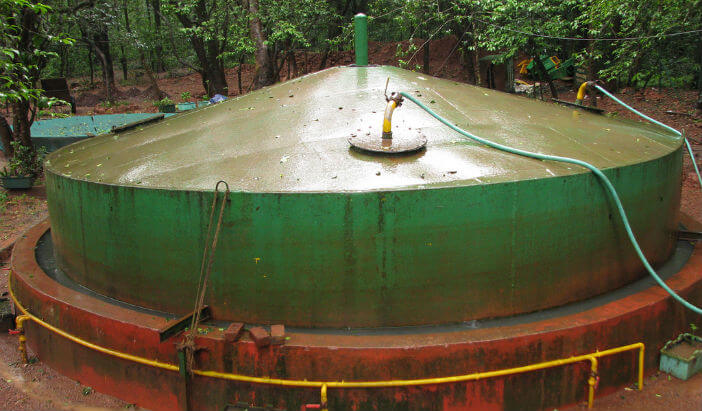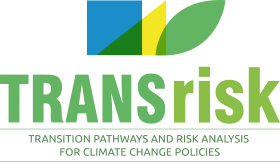One of the 15 case studies of the EU-funded TRANSrisk project on transition pathways for climate change mitigation strategies is focused on the biogas sector in Indonesia. In this article, we explore the emissions reduction potential of a wider implementation of biogas in Indonesia.
One of the 15 case studies of the EU-funded TRANSrisk project on transition pathways for climate change mitigation strategies is focused on the biogas sector in Indonesia. In a first report, there has been a focus on mapping the costs and benefits of biogas technology implementation on a household scale, and this is compared with the current dominant form of cooking fuel, i.e. fuel wood.
The country case study context report 'Indonesia: Bioenergy' (pdf) can be downloaded from the TRANSrisk project website. The report has been prepared by Takeshi Takama, Ibnu Budiman, Auditya Sari, Cynthia J. Ismail, Novelita Mondamina, Ivan G. Bobashev, Stefan Bößner, and Timothy Suljada (Stockholm Environment Institute).
One of the 15 case studies of the EU-funded TRANSrisk project on transition pathways for climate change mitigation strategies is focused on the biogas sector in Indonesia. In a first report, there has been a focus on mapping the costs and benefits of biogas technology implementation on a household scale, and this is compared with the current dominant form of cooking fuel, i.e. fuel wood.
The country case study context report 'Indonesia: Bioenergy' (pdf) can be downloaded from the TRANSrisk project website. The report has been prepared by Takeshi Takama, Ibnu Budiman, Auditya Sari, Cynthia J. Ismail, Novelita Mondamina, Ivan G. Bobashev, Stefan Bößner, and Timothy Suljada (Stockholm Environment Institute).
Transition pathways
Both options (biogas and fuel wood) focus on household-level application. There are some experiences with biogas plants in Indonesia. One of the examples, the biogas programme named BIRU, was initiated through a collaboration between the Ministry of Energy and Mineral Resources (ESDM) and the SNV Netherlands Development Organisation.

The installation of household-scale biogas technology is summarised in Figure 1, consisting of an integrated system of a fix dome, a main gas valve and post-manure treatment. Biogas production generally contains 50% of CH4. Manure-based biogas production can help to not only reduce methane (CH4) and carbon dioxide (CO2) emissions, but also improve the water quality of rivers. By collecting and processing animal manure, the remaining organic carbon (as well as phosphates and nitrates) digestate, commonly known as bio-slurry, can be submitted to agricultural soils that are increasingly degraded. Up until now, chemical fertiliser is still frequently used by the farmers. With a biogas installation, the use of chemical fertilisers could be reduced.
In general, bio-slurry will be produced everyday after biogas production, as manure will be a daily input to the digester. In the case that the mix ratio of manure and water is 1:1, the composition of bio-slurry is 93% water and 7% dry matter. The NPK content in this liquid bio-slurry is about 0.25% (N), 0.13% (P), and 0.12% (K). Liquid bio-slurry can be immediately applied by farmers to the lands. Solid bio-slurry takes around 40 days before application due to a natural drying process, and is used during soil processing and the mid-growing season.
Another positive aspect of using biogas is that it minimises health issues (such as respiratory problems and eye illness) that occur due to burning of firewood. However, some parts of areas in Indonesia still depend on fuel wood usage for cooking, and this practice is likely to continue due to cultural and economic factors. Also, limited training for maintenance of existing digester systems might contribute to the current low use of biogas.
Evaluation of pathways
The implementation of biogas technology at the household scale is foreseen to spread among as many as possible households in Indonesia, especially for people living in rural areas. Using biogas for cooking will positively impact health, especially for women and children, and mitigate climate change through among others CH4 and CO2 emissions reduction. Also, biogas utilisation will enhance the water quality of the rivers, since there will be no animal dung discharged to rivers. In addition, using biogas provides economic opportunities for households, as biogas production pre-empts the household from purchasing fuel as well as fertiliser.
However, the initial costs of installing biogas technology still need to be evaluated. Since it requires to be integrated with cooking and a post-manure treatment system, the installation costs are quite high: between USD 400 and 700 depending on the size of the digester, according to the BIRU programme. This hinders the affordability of household-scale biogas technology. The regulated minimum wage in Indonesia, established per province, is about IDR 1.5 to 2.5 million per month (about USD 110 to 180 per month). However, farmers’ incomes are not regulated, and are generally below the minimum wage. Therefore, the cost of a biogas digester is likely to be more than half of the annual income. In order to increase the use of biogas, an encouragement to apply for low-interest credit would therefore be required. The BIRU programme, in addition, offers a subsidy for farmers: they only need to pay 60-80% of the total installation costs.
The regular maintenance costs for household-scale biogas technology are insignificant. In general, the farmers just need to put attention to the gas pipelines to check for leakages. Hard maintenance of the digester operation will require a certified technician, as provided through the BIRU programme.
On the other hand, fuelwood usage for cooking seems to be more realistic, based on the high initial costs of the biogas technology. The fuel wood, particularly from tree branches, can be obtained cheaply or even for free, and only the inexpensive stove will need to be purchased. However, the environmental and society issue could arise: smoke production during the cooking process, and the labour-intensive work of firewood collection. These conditions could increase health problems, and affect mortality rates particularly for women and children.
Further research
Next steps of the research on biogas technology transition pathways in the TRANSrisk project include a (macro-)economic assessment with economic models, and research on factors which influence the implementation of biogas on the household-scale. This analysis will help to develop a better approach to reach a higher acceptance of biogas, and to increase awareness of the need for climate change mitigation among the Indonesian population.
The country case study context report 'Indonesia: Bioenergy' (pdf) can be downloaded from the TRANSrisk project website (www.transrisk-project.eu).

This article is an output of the EU-funded TRANSrisk project.
TRANSrisk
Project details
- Project title: “Transitions Pathways and Risk Analysis for Climate Change Mitigation and Adaption Strategies” (TRANSrisk)
- Funding scheme: European Union Horizon 2020 Programme (EU H2020, grant agreement no. 642260)
- Duration: 3 years (1 September 2015 – 31 August 2018)
- Project coordinator: Science Policy Research Unit, University of Sussex, United Kingdom
- Project website: www.transrisk-project.eu


